Critical Evaluation: Significance of Tort Law in Business Operations
VerifiedAdded on 2022/11/17
|9
|2351
|298
Essay
AI Summary
This essay critically examines the significance of tort law for business operations, highlighting its role in providing defense against economic losses resulting from illegal conducts. It discusses the four elements of tort law (duty, breach, causation, and injury) and the three major categories: strict liability, negligence, and intentional tort. The essay emphasizes the importance of tort law in holding individuals and organizations accountable for damages, deterring misconduct, and providing remedies such as financial compensation and injunctions. It also explores various types of torts, including negligence, intentional torts, toxic torts, and nuisance, and their implications for businesses. Furthermore, the essay delves into the remedies available for business torts, such as economic damages and injunctions, underscoring the need for measurable certainty in assessing financial losses. The analysis concludes that tort law serves as an incentive system for responsible behavior, promoting safety and accountability within the business environment.
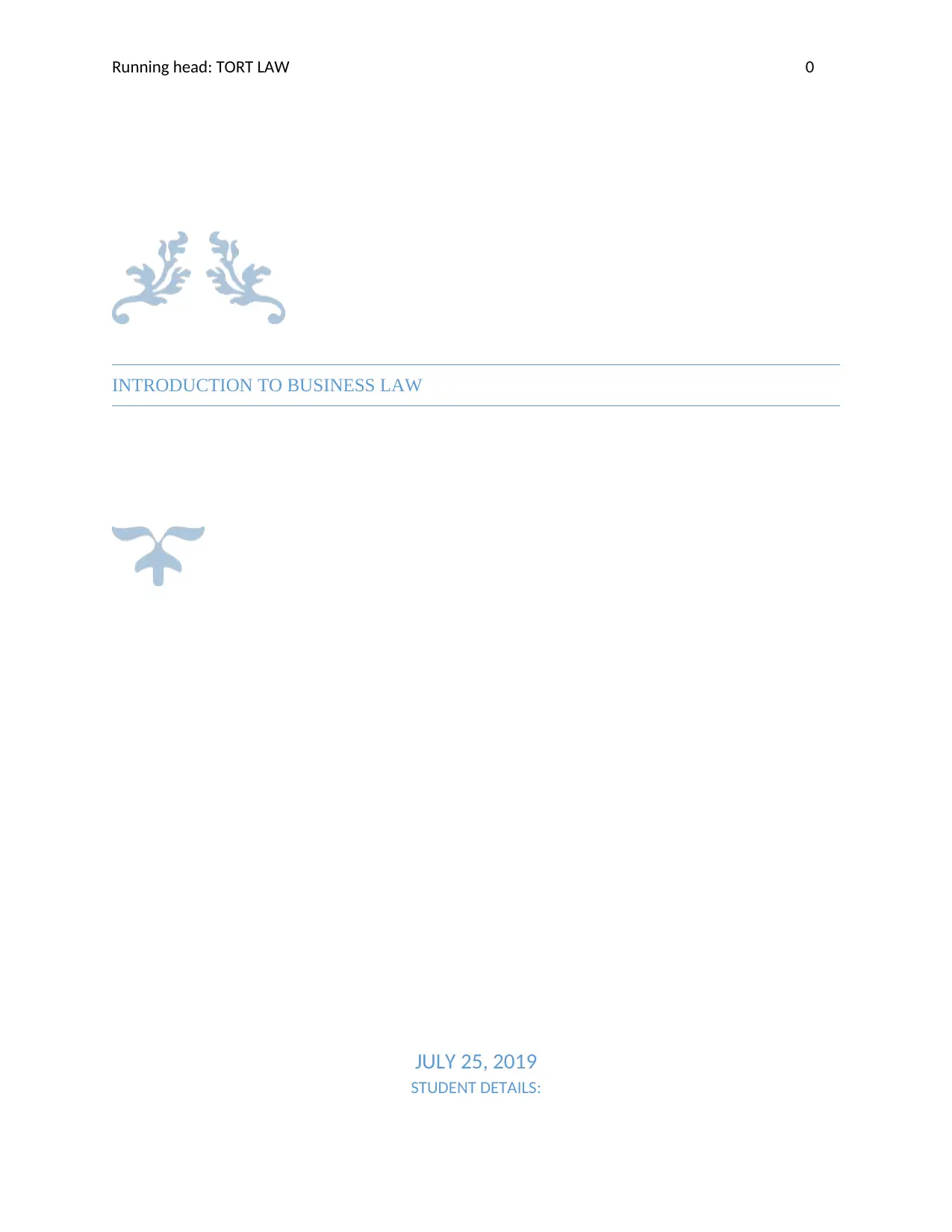
Running head: TORT LAW 0
INTRODUCTION TO BUSINESS LAW
JULY 25, 2019
STUDENT DETAILS:
INTRODUCTION TO BUSINESS LAW
JULY 25, 2019
STUDENT DETAILS:
Paraphrase This Document
Need a fresh take? Get an instant paraphrase of this document with our AI Paraphraser
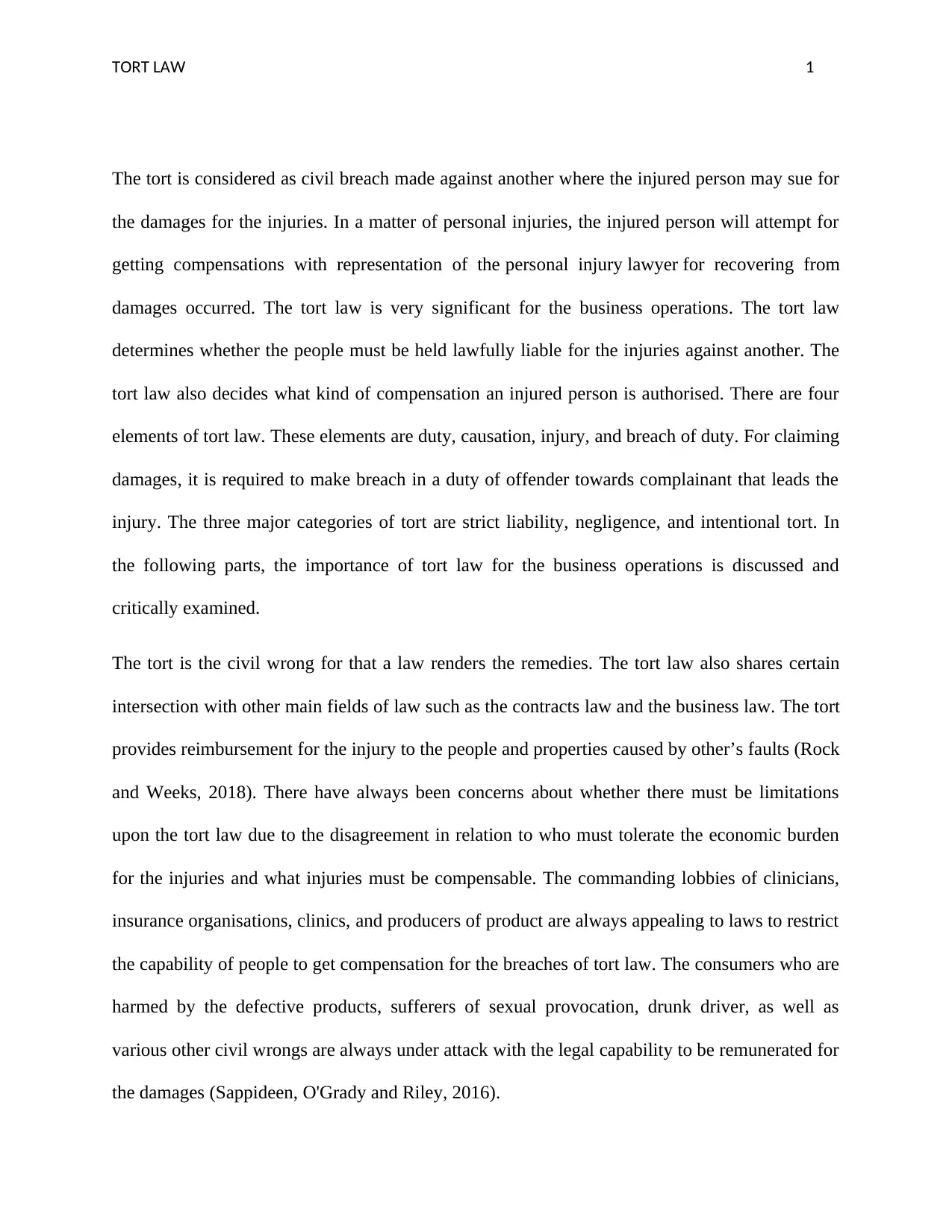
TORT LAW 1
The tort is considered as civil breach made against another where the injured person may sue for
the damages for the injuries. In a matter of personal injuries, the injured person will attempt for
getting compensations with representation of the personal injury lawyer for recovering from
damages occurred. The tort law is very significant for the business operations. The tort law
determines whether the people must be held lawfully liable for the injuries against another. The
tort law also decides what kind of compensation an injured person is authorised. There are four
elements of tort law. These elements are duty, causation, injury, and breach of duty. For claiming
damages, it is required to make breach in a duty of offender towards complainant that leads the
injury. The three major categories of tort are strict liability, negligence, and intentional tort. In
the following parts, the importance of tort law for the business operations is discussed and
critically examined.
The tort is the civil wrong for that a law renders the remedies. The tort law also shares certain
intersection with other main fields of law such as the contracts law and the business law. The tort
provides reimbursement for the injury to the people and properties caused by other’s faults (Rock
and Weeks, 2018). There have always been concerns about whether there must be limitations
upon the tort law due to the disagreement in relation to who must tolerate the economic burden
for the injuries and what injuries must be compensable. The commanding lobbies of clinicians,
insurance organisations, clinics, and producers of product are always appealing to laws to restrict
the capability of people to get compensation for the breaches of tort law. The consumers who are
harmed by the defective products, sufferers of sexual provocation, drunk driver, as well as
various other civil wrongs are always under attack with the legal capability to be remunerated for
the damages (Sappideen, O'Grady and Riley, 2016).
The tort is considered as civil breach made against another where the injured person may sue for
the damages for the injuries. In a matter of personal injuries, the injured person will attempt for
getting compensations with representation of the personal injury lawyer for recovering from
damages occurred. The tort law is very significant for the business operations. The tort law
determines whether the people must be held lawfully liable for the injuries against another. The
tort law also decides what kind of compensation an injured person is authorised. There are four
elements of tort law. These elements are duty, causation, injury, and breach of duty. For claiming
damages, it is required to make breach in a duty of offender towards complainant that leads the
injury. The three major categories of tort are strict liability, negligence, and intentional tort. In
the following parts, the importance of tort law for the business operations is discussed and
critically examined.
The tort is the civil wrong for that a law renders the remedies. The tort law also shares certain
intersection with other main fields of law such as the contracts law and the business law. The tort
provides reimbursement for the injury to the people and properties caused by other’s faults (Rock
and Weeks, 2018). There have always been concerns about whether there must be limitations
upon the tort law due to the disagreement in relation to who must tolerate the economic burden
for the injuries and what injuries must be compensable. The commanding lobbies of clinicians,
insurance organisations, clinics, and producers of product are always appealing to laws to restrict
the capability of people to get compensation for the breaches of tort law. The consumers who are
harmed by the defective products, sufferers of sexual provocation, drunk driver, as well as
various other civil wrongs are always under attack with the legal capability to be remunerated for
the damages (Sappideen, O'Grady and Riley, 2016).
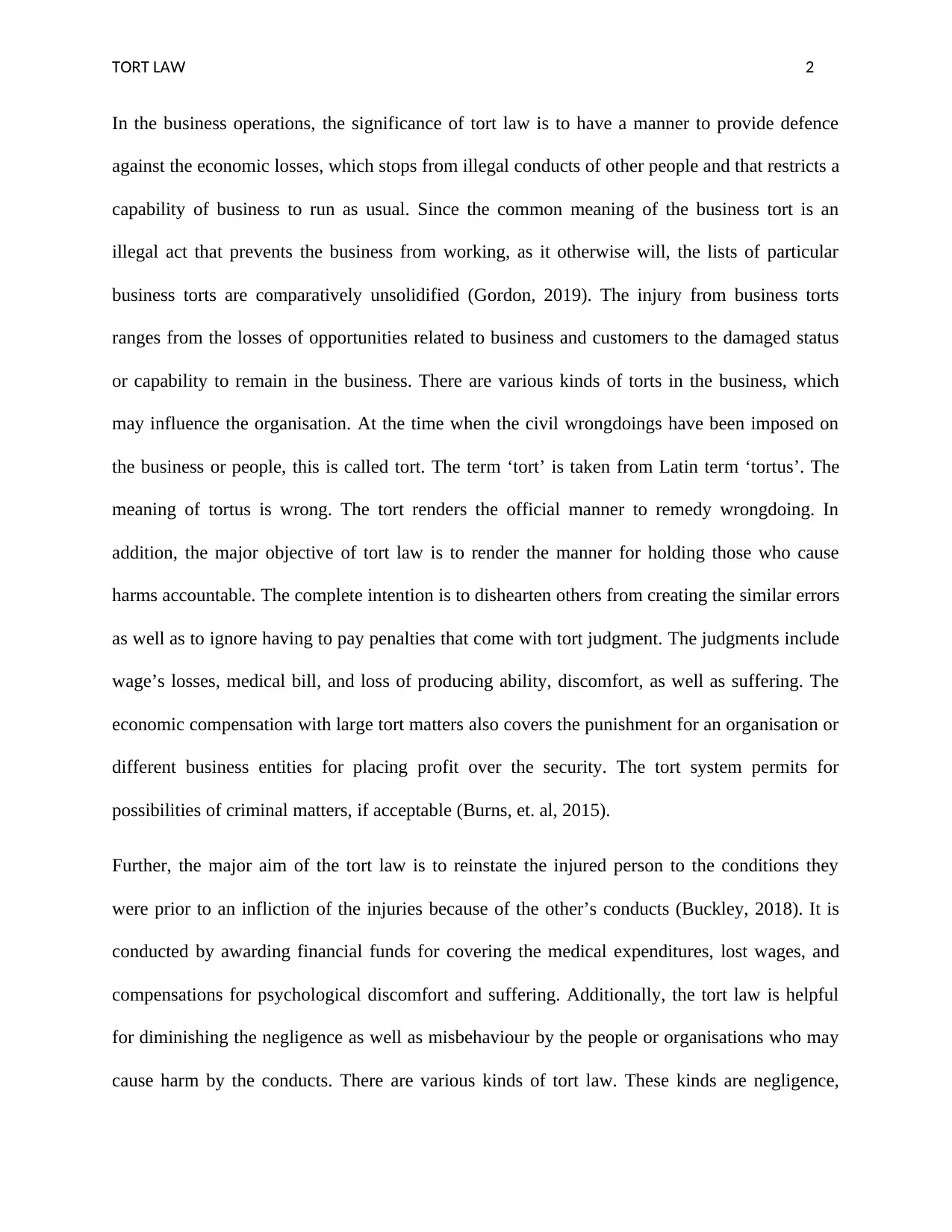
TORT LAW 2
In the business operations, the significance of tort law is to have a manner to provide defence
against the economic losses, which stops from illegal conducts of other people and that restricts a
capability of business to run as usual. Since the common meaning of the business tort is an
illegal act that prevents the business from working, as it otherwise will, the lists of particular
business torts are comparatively unsolidified (Gordon, 2019). The injury from business torts
ranges from the losses of opportunities related to business and customers to the damaged status
or capability to remain in the business. There are various kinds of torts in the business, which
may influence the organisation. At the time when the civil wrongdoings have been imposed on
the business or people, this is called tort. The term ‘tort’ is taken from Latin term ‘tortus’. The
meaning of tortus is wrong. The tort renders the official manner to remedy wrongdoing. In
addition, the major objective of tort law is to render the manner for holding those who cause
harms accountable. The complete intention is to dishearten others from creating the similar errors
as well as to ignore having to pay penalties that come with tort judgment. The judgments include
wage’s losses, medical bill, and loss of producing ability, discomfort, as well as suffering. The
economic compensation with large tort matters also covers the punishment for an organisation or
different business entities for placing profit over the security. The tort system permits for
possibilities of criminal matters, if acceptable (Burns, et. al, 2015).
Further, the major aim of the tort law is to reinstate the injured person to the conditions they
were prior to an infliction of the injuries because of the other’s conducts (Buckley, 2018). It is
conducted by awarding financial funds for covering the medical expenditures, lost wages, and
compensations for psychological discomfort and suffering. Additionally, the tort law is helpful
for diminishing the negligence as well as misbehaviour by the people or organisations who may
cause harm by the conducts. There are various kinds of tort law. These kinds are negligence,
In the business operations, the significance of tort law is to have a manner to provide defence
against the economic losses, which stops from illegal conducts of other people and that restricts a
capability of business to run as usual. Since the common meaning of the business tort is an
illegal act that prevents the business from working, as it otherwise will, the lists of particular
business torts are comparatively unsolidified (Gordon, 2019). The injury from business torts
ranges from the losses of opportunities related to business and customers to the damaged status
or capability to remain in the business. There are various kinds of torts in the business, which
may influence the organisation. At the time when the civil wrongdoings have been imposed on
the business or people, this is called tort. The term ‘tort’ is taken from Latin term ‘tortus’. The
meaning of tortus is wrong. The tort renders the official manner to remedy wrongdoing. In
addition, the major objective of tort law is to render the manner for holding those who cause
harms accountable. The complete intention is to dishearten others from creating the similar errors
as well as to ignore having to pay penalties that come with tort judgment. The judgments include
wage’s losses, medical bill, and loss of producing ability, discomfort, as well as suffering. The
economic compensation with large tort matters also covers the punishment for an organisation or
different business entities for placing profit over the security. The tort system permits for
possibilities of criminal matters, if acceptable (Burns, et. al, 2015).
Further, the major aim of the tort law is to reinstate the injured person to the conditions they
were prior to an infliction of the injuries because of the other’s conducts (Buckley, 2018). It is
conducted by awarding financial funds for covering the medical expenditures, lost wages, and
compensations for psychological discomfort and suffering. Additionally, the tort law is helpful
for diminishing the negligence as well as misbehaviour by the people or organisations who may
cause harm by the conducts. There are various kinds of tort law. These kinds are negligence,
⊘ This is a preview!⊘
Do you want full access?
Subscribe today to unlock all pages.

Trusted by 1+ million students worldwide
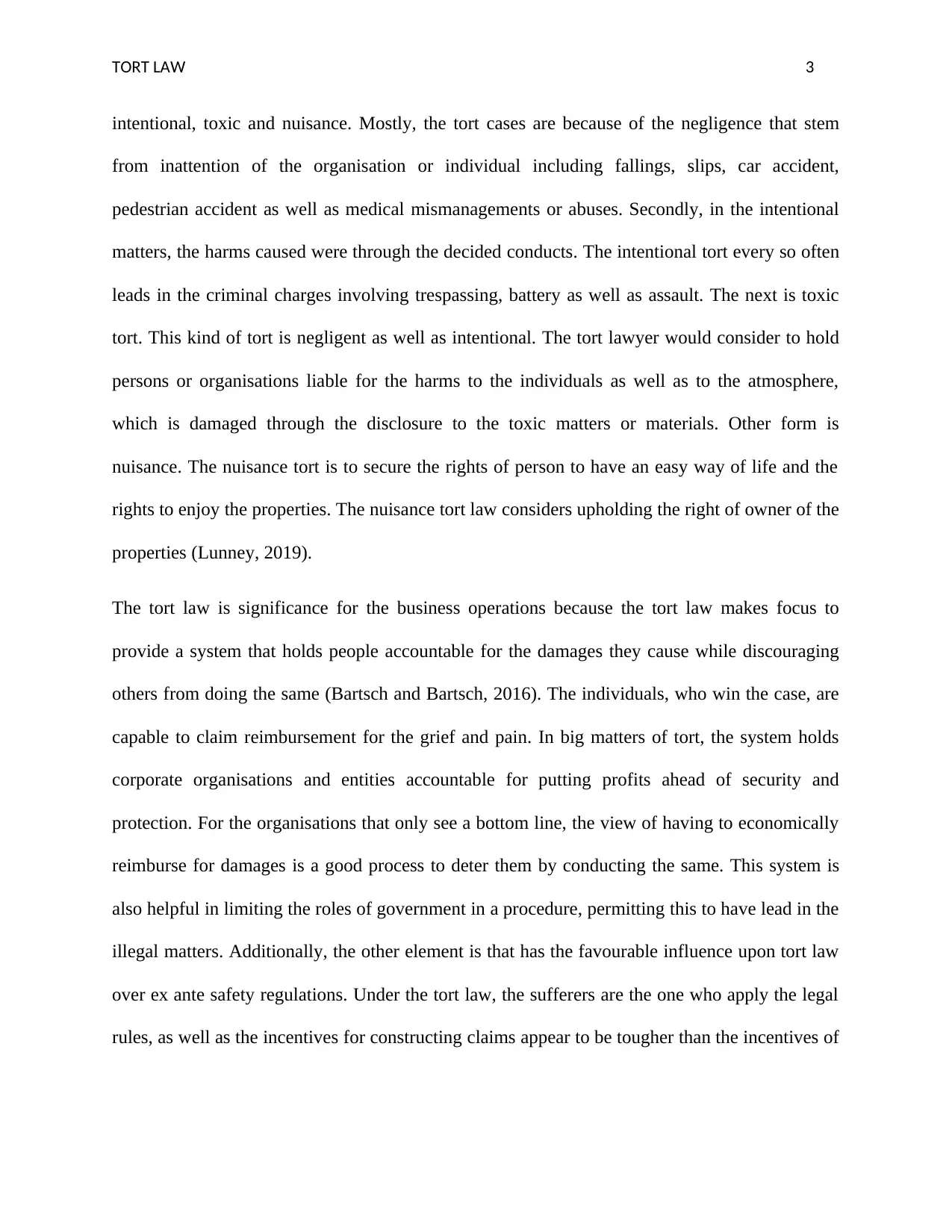
TORT LAW 3
intentional, toxic and nuisance. Mostly, the tort cases are because of the negligence that stem
from inattention of the organisation or individual including fallings, slips, car accident,
pedestrian accident as well as medical mismanagements or abuses. Secondly, in the intentional
matters, the harms caused were through the decided conducts. The intentional tort every so often
leads in the criminal charges involving trespassing, battery as well as assault. The next is toxic
tort. This kind of tort is negligent as well as intentional. The tort lawyer would consider to hold
persons or organisations liable for the harms to the individuals as well as to the atmosphere,
which is damaged through the disclosure to the toxic matters or materials. Other form is
nuisance. The nuisance tort is to secure the rights of person to have an easy way of life and the
rights to enjoy the properties. The nuisance tort law considers upholding the right of owner of the
properties (Lunney, 2019).
The tort law is significance for the business operations because the tort law makes focus to
provide a system that holds people accountable for the damages they cause while discouraging
others from doing the same (Bartsch and Bartsch, 2016). The individuals, who win the case, are
capable to claim reimbursement for the grief and pain. In big matters of tort, the system holds
corporate organisations and entities accountable for putting profits ahead of security and
protection. For the organisations that only see a bottom line, the view of having to economically
reimburse for damages is a good process to deter them by conducting the same. This system is
also helpful in limiting the roles of government in a procedure, permitting this to have lead in the
illegal matters. Additionally, the other element is that has the favourable influence upon tort law
over ex ante safety regulations. Under the tort law, the sufferers are the one who apply the legal
rules, as well as the incentives for constructing claims appear to be tougher than the incentives of
intentional, toxic and nuisance. Mostly, the tort cases are because of the negligence that stem
from inattention of the organisation or individual including fallings, slips, car accident,
pedestrian accident as well as medical mismanagements or abuses. Secondly, in the intentional
matters, the harms caused were through the decided conducts. The intentional tort every so often
leads in the criminal charges involving trespassing, battery as well as assault. The next is toxic
tort. This kind of tort is negligent as well as intentional. The tort lawyer would consider to hold
persons or organisations liable for the harms to the individuals as well as to the atmosphere,
which is damaged through the disclosure to the toxic matters or materials. Other form is
nuisance. The nuisance tort is to secure the rights of person to have an easy way of life and the
rights to enjoy the properties. The nuisance tort law considers upholding the right of owner of the
properties (Lunney, 2019).
The tort law is significance for the business operations because the tort law makes focus to
provide a system that holds people accountable for the damages they cause while discouraging
others from doing the same (Bartsch and Bartsch, 2016). The individuals, who win the case, are
capable to claim reimbursement for the grief and pain. In big matters of tort, the system holds
corporate organisations and entities accountable for putting profits ahead of security and
protection. For the organisations that only see a bottom line, the view of having to economically
reimburse for damages is a good process to deter them by conducting the same. This system is
also helpful in limiting the roles of government in a procedure, permitting this to have lead in the
illegal matters. Additionally, the other element is that has the favourable influence upon tort law
over ex ante safety regulations. Under the tort law, the sufferers are the one who apply the legal
rules, as well as the incentives for constructing claims appear to be tougher than the incentives of
Paraphrase This Document
Need a fresh take? Get an instant paraphrase of this document with our AI Paraphraser
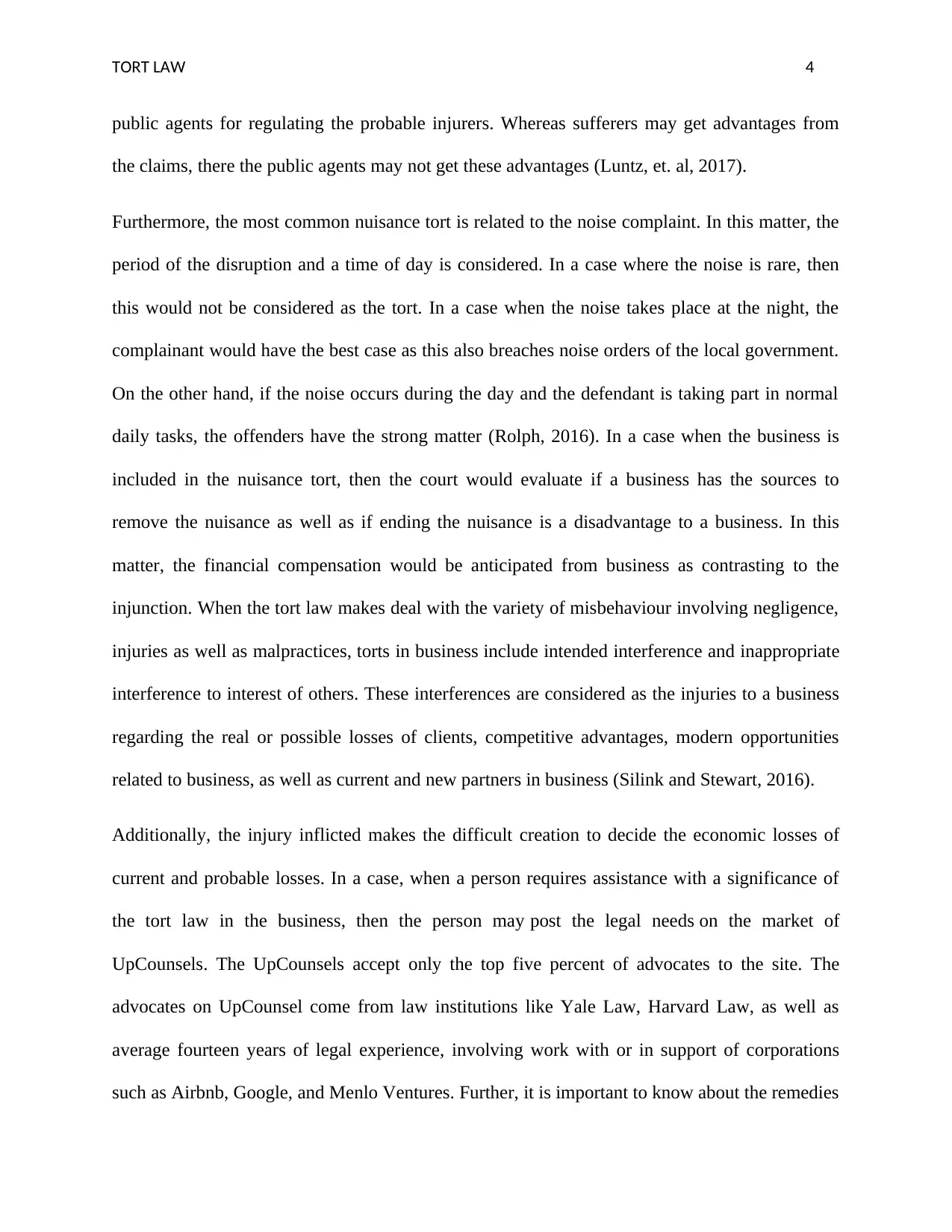
TORT LAW 4
public agents for regulating the probable injurers. Whereas sufferers may get advantages from
the claims, there the public agents may not get these advantages (Luntz, et. al, 2017).
Furthermore, the most common nuisance tort is related to the noise complaint. In this matter, the
period of the disruption and a time of day is considered. In a case where the noise is rare, then
this would not be considered as the tort. In a case when the noise takes place at the night, the
complainant would have the best case as this also breaches noise orders of the local government.
On the other hand, if the noise occurs during the day and the defendant is taking part in normal
daily tasks, the offenders have the strong matter (Rolph, 2016). In a case when the business is
included in the nuisance tort, then the court would evaluate if a business has the sources to
remove the nuisance as well as if ending the nuisance is a disadvantage to a business. In this
matter, the financial compensation would be anticipated from business as contrasting to the
injunction. When the tort law makes deal with the variety of misbehaviour involving negligence,
injuries as well as malpractices, torts in business include intended interference and inappropriate
interference to interest of others. These interferences are considered as the injuries to a business
regarding the real or possible losses of clients, competitive advantages, modern opportunities
related to business, as well as current and new partners in business (Silink and Stewart, 2016).
Additionally, the injury inflicted makes the difficult creation to decide the economic losses of
current and probable losses. In a case, when a person requires assistance with a significance of
the tort law in the business, then the person may post the legal needs on the market of
UpCounsels. The UpCounsels accept only the top five percent of advocates to the site. The
advocates on UpCounsel come from law institutions like Yale Law, Harvard Law, as well as
average fourteen years of legal experience, involving work with or in support of corporations
such as Airbnb, Google, and Menlo Ventures. Further, it is important to know about the remedies
public agents for regulating the probable injurers. Whereas sufferers may get advantages from
the claims, there the public agents may not get these advantages (Luntz, et. al, 2017).
Furthermore, the most common nuisance tort is related to the noise complaint. In this matter, the
period of the disruption and a time of day is considered. In a case where the noise is rare, then
this would not be considered as the tort. In a case when the noise takes place at the night, the
complainant would have the best case as this also breaches noise orders of the local government.
On the other hand, if the noise occurs during the day and the defendant is taking part in normal
daily tasks, the offenders have the strong matter (Rolph, 2016). In a case when the business is
included in the nuisance tort, then the court would evaluate if a business has the sources to
remove the nuisance as well as if ending the nuisance is a disadvantage to a business. In this
matter, the financial compensation would be anticipated from business as contrasting to the
injunction. When the tort law makes deal with the variety of misbehaviour involving negligence,
injuries as well as malpractices, torts in business include intended interference and inappropriate
interference to interest of others. These interferences are considered as the injuries to a business
regarding the real or possible losses of clients, competitive advantages, modern opportunities
related to business, as well as current and new partners in business (Silink and Stewart, 2016).
Additionally, the injury inflicted makes the difficult creation to decide the economic losses of
current and probable losses. In a case, when a person requires assistance with a significance of
the tort law in the business, then the person may post the legal needs on the market of
UpCounsels. The UpCounsels accept only the top five percent of advocates to the site. The
advocates on UpCounsel come from law institutions like Yale Law, Harvard Law, as well as
average fourteen years of legal experience, involving work with or in support of corporations
such as Airbnb, Google, and Menlo Ventures. Further, it is important to know about the remedies
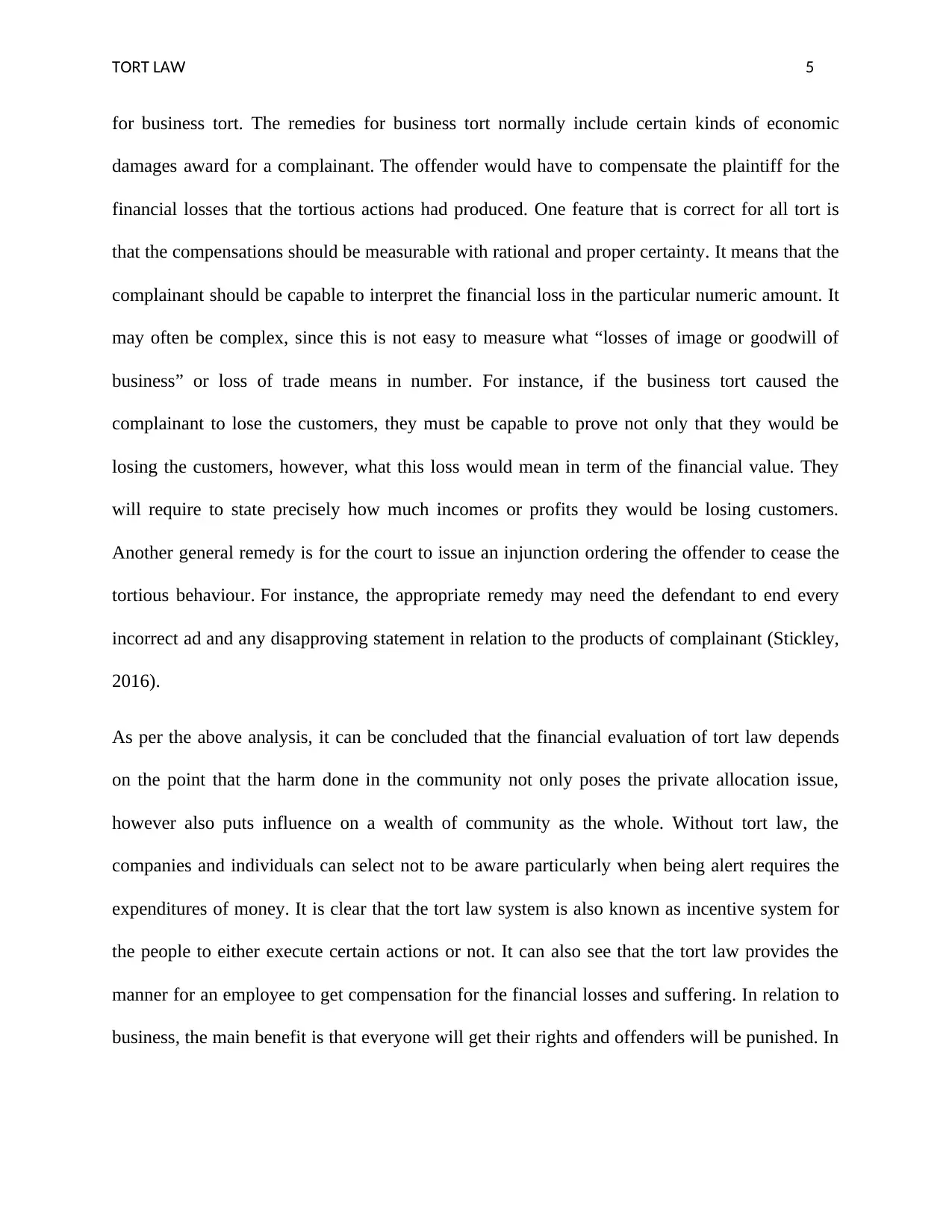
TORT LAW 5
for business tort. The remedies for business tort normally include certain kinds of economic
damages award for a complainant. The offender would have to compensate the plaintiff for the
financial losses that the tortious actions had produced. One feature that is correct for all tort is
that the compensations should be measurable with rational and proper certainty. It means that the
complainant should be capable to interpret the financial loss in the particular numeric amount. It
may often be complex, since this is not easy to measure what “losses of image or goodwill of
business” or loss of trade means in number. For instance, if the business tort caused the
complainant to lose the customers, they must be capable to prove not only that they would be
losing the customers, however, what this loss would mean in term of the financial value. They
will require to state precisely how much incomes or profits they would be losing customers.
Another general remedy is for the court to issue an injunction ordering the offender to cease the
tortious behaviour. For instance, the appropriate remedy may need the defendant to end every
incorrect ad and any disapproving statement in relation to the products of complainant (Stickley,
2016).
As per the above analysis, it can be concluded that the financial evaluation of tort law depends
on the point that the harm done in the community not only poses the private allocation issue,
however also puts influence on a wealth of community as the whole. Without tort law, the
companies and individuals can select not to be aware particularly when being alert requires the
expenditures of money. It is clear that the tort law system is also known as incentive system for
the people to either execute certain actions or not. It can also see that the tort law provides the
manner for an employee to get compensation for the financial losses and suffering. In relation to
business, the main benefit is that everyone will get their rights and offenders will be punished. In
for business tort. The remedies for business tort normally include certain kinds of economic
damages award for a complainant. The offender would have to compensate the plaintiff for the
financial losses that the tortious actions had produced. One feature that is correct for all tort is
that the compensations should be measurable with rational and proper certainty. It means that the
complainant should be capable to interpret the financial loss in the particular numeric amount. It
may often be complex, since this is not easy to measure what “losses of image or goodwill of
business” or loss of trade means in number. For instance, if the business tort caused the
complainant to lose the customers, they must be capable to prove not only that they would be
losing the customers, however, what this loss would mean in term of the financial value. They
will require to state precisely how much incomes or profits they would be losing customers.
Another general remedy is for the court to issue an injunction ordering the offender to cease the
tortious behaviour. For instance, the appropriate remedy may need the defendant to end every
incorrect ad and any disapproving statement in relation to the products of complainant (Stickley,
2016).
As per the above analysis, it can be concluded that the financial evaluation of tort law depends
on the point that the harm done in the community not only poses the private allocation issue,
however also puts influence on a wealth of community as the whole. Without tort law, the
companies and individuals can select not to be aware particularly when being alert requires the
expenditures of money. It is clear that the tort law system is also known as incentive system for
the people to either execute certain actions or not. It can also see that the tort law provides the
manner for an employee to get compensation for the financial losses and suffering. In relation to
business, the main benefit is that everyone will get their rights and offenders will be punished. In
⊘ This is a preview!⊘
Do you want full access?
Subscribe today to unlock all pages.

Trusted by 1+ million students worldwide
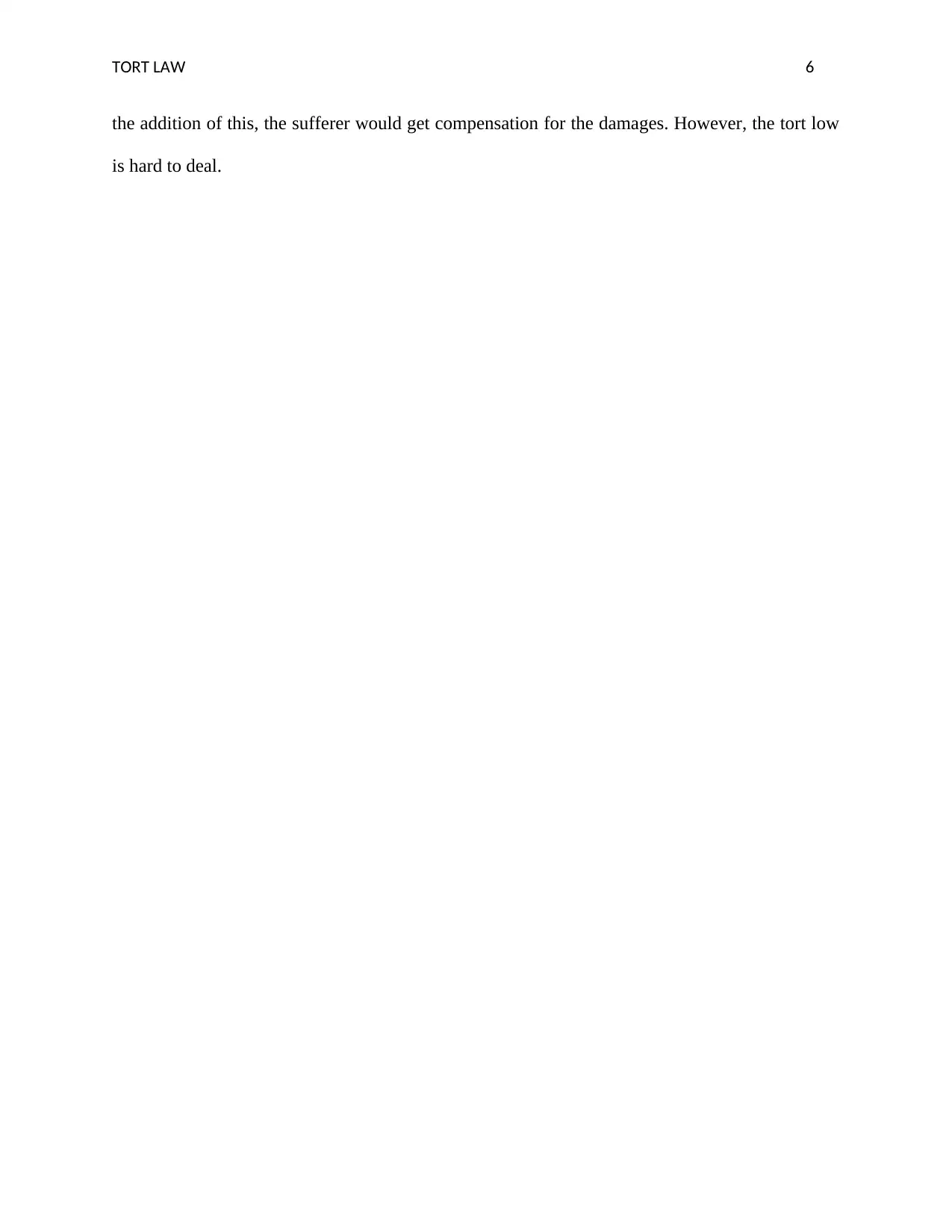
TORT LAW 6
the addition of this, the sufferer would get compensation for the damages. However, the tort low
is hard to deal.
the addition of this, the sufferer would get compensation for the damages. However, the tort low
is hard to deal.
Paraphrase This Document
Need a fresh take? Get an instant paraphrase of this document with our AI Paraphraser
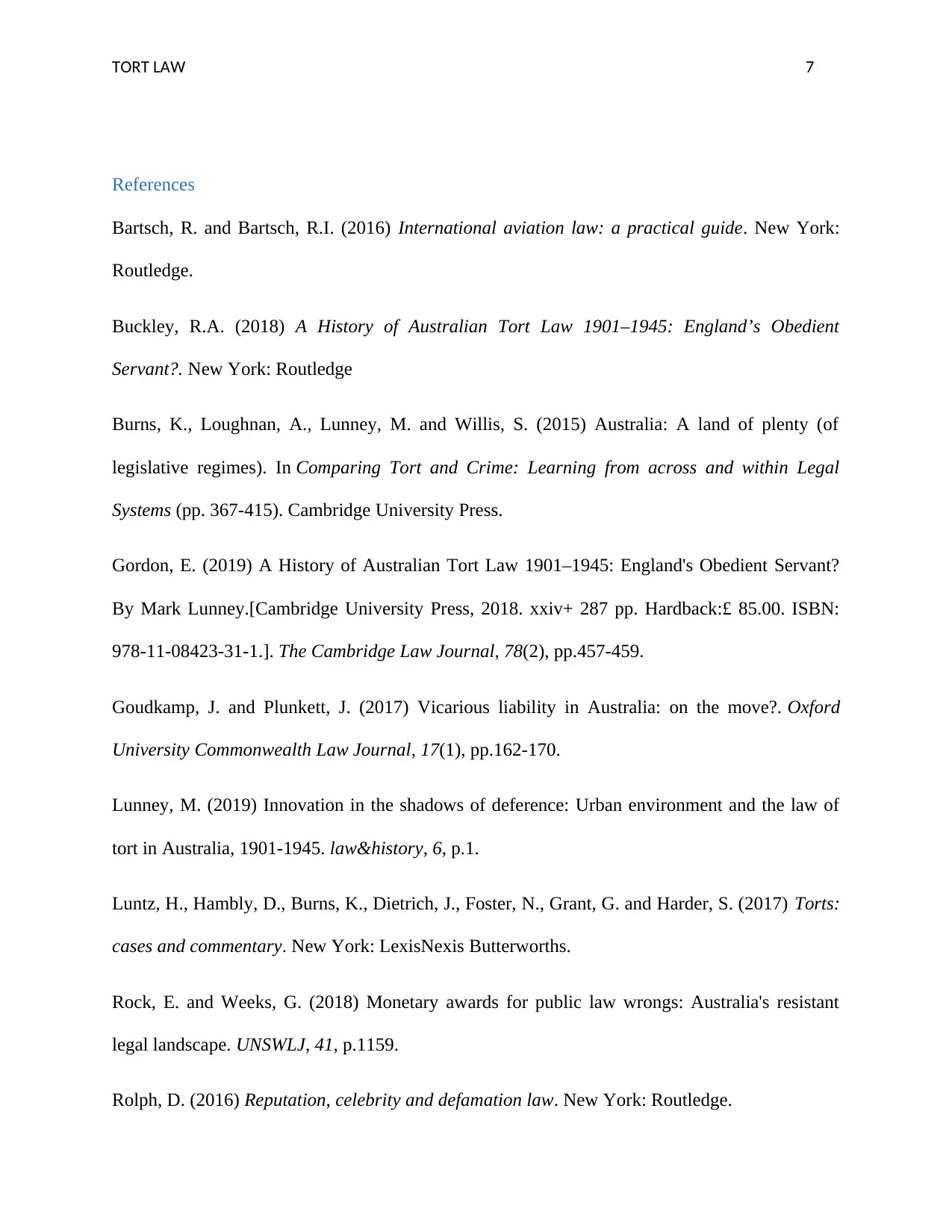
TORT LAW 7
References
Bartsch, R. and Bartsch, R.I. (2016) International aviation law: a practical guide. New York:
Routledge.
Buckley, R.A. (2018) A History of Australian Tort Law 1901–1945: England’s Obedient
Servant?. New York: Routledge
Burns, K., Loughnan, A., Lunney, M. and Willis, S. (2015) Australia: A land of plenty (of
legislative regimes). In Comparing Tort and Crime: Learning from across and within Legal
Systems (pp. 367-415). Cambridge University Press.
Gordon, E. (2019) A History of Australian Tort Law 1901–1945: England's Obedient Servant?
By Mark Lunney.[Cambridge University Press, 2018. xxiv+ 287 pp. Hardback:£ 85.00. ISBN:
978-11-08423-31-1.]. The Cambridge Law Journal, 78(2), pp.457-459.
Goudkamp, J. and Plunkett, J. (2017) Vicarious liability in Australia: on the move?. Oxford
University Commonwealth Law Journal, 17(1), pp.162-170.
Lunney, M. (2019) Innovation in the shadows of deference: Urban environment and the law of
tort in Australia, 1901-1945. law&history, 6, p.1.
Luntz, H., Hambly, D., Burns, K., Dietrich, J., Foster, N., Grant, G. and Harder, S. (2017) Torts:
cases and commentary. New York: LexisNexis Butterworths.
Rock, E. and Weeks, G. (2018) Monetary awards for public law wrongs: Australia's resistant
legal landscape. UNSWLJ, 41, p.1159.
Rolph, D. (2016) Reputation, celebrity and defamation law. New York: Routledge.
References
Bartsch, R. and Bartsch, R.I. (2016) International aviation law: a practical guide. New York:
Routledge.
Buckley, R.A. (2018) A History of Australian Tort Law 1901–1945: England’s Obedient
Servant?. New York: Routledge
Burns, K., Loughnan, A., Lunney, M. and Willis, S. (2015) Australia: A land of plenty (of
legislative regimes). In Comparing Tort and Crime: Learning from across and within Legal
Systems (pp. 367-415). Cambridge University Press.
Gordon, E. (2019) A History of Australian Tort Law 1901–1945: England's Obedient Servant?
By Mark Lunney.[Cambridge University Press, 2018. xxiv+ 287 pp. Hardback:£ 85.00. ISBN:
978-11-08423-31-1.]. The Cambridge Law Journal, 78(2), pp.457-459.
Goudkamp, J. and Plunkett, J. (2017) Vicarious liability in Australia: on the move?. Oxford
University Commonwealth Law Journal, 17(1), pp.162-170.
Lunney, M. (2019) Innovation in the shadows of deference: Urban environment and the law of
tort in Australia, 1901-1945. law&history, 6, p.1.
Luntz, H., Hambly, D., Burns, K., Dietrich, J., Foster, N., Grant, G. and Harder, S. (2017) Torts:
cases and commentary. New York: LexisNexis Butterworths.
Rock, E. and Weeks, G. (2018) Monetary awards for public law wrongs: Australia's resistant
legal landscape. UNSWLJ, 41, p.1159.
Rolph, D. (2016) Reputation, celebrity and defamation law. New York: Routledge.
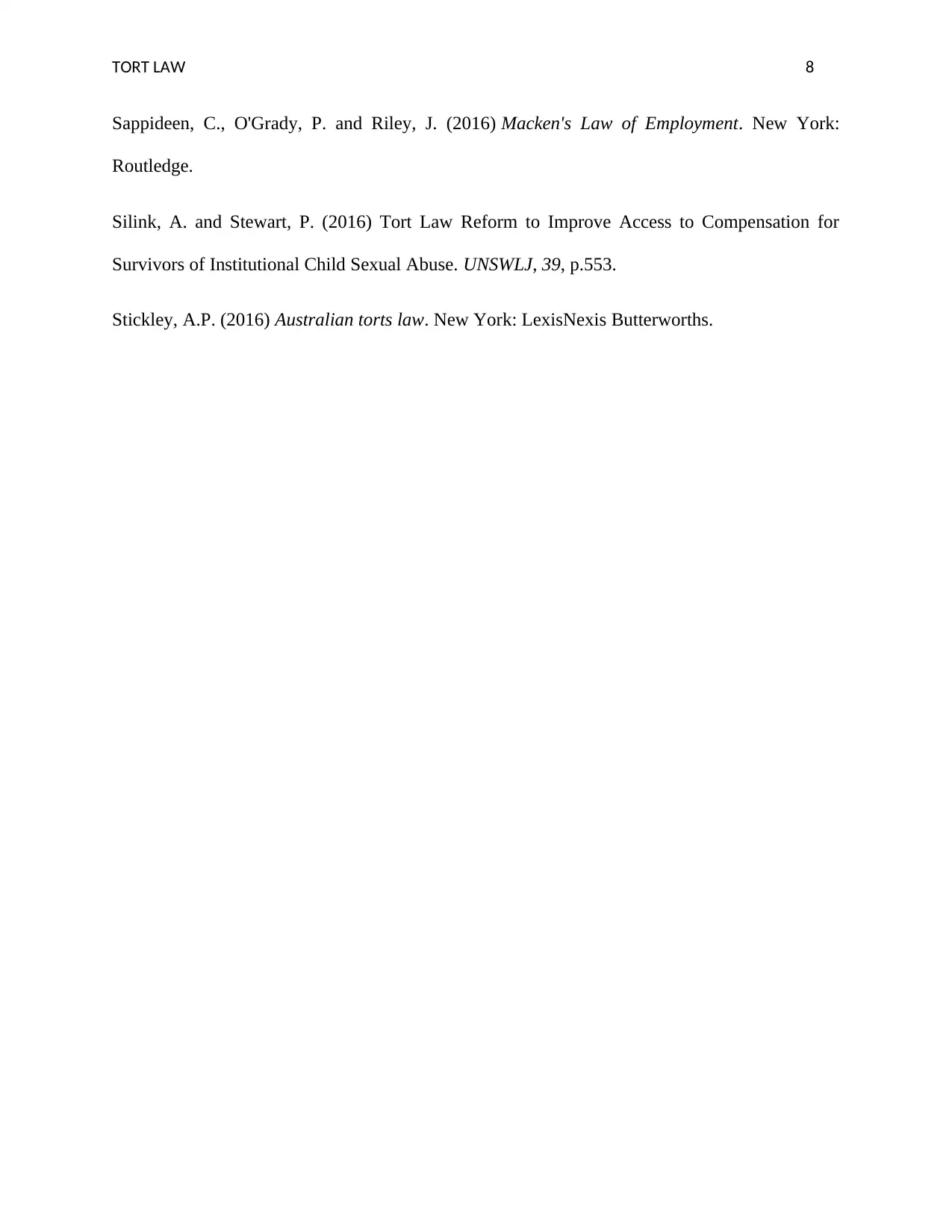
TORT LAW 8
Sappideen, C., O'Grady, P. and Riley, J. (2016) Macken's Law of Employment. New York:
Routledge.
Silink, A. and Stewart, P. (2016) Tort Law Reform to Improve Access to Compensation for
Survivors of Institutional Child Sexual Abuse. UNSWLJ, 39, p.553.
Stickley, A.P. (2016) Australian torts law. New York: LexisNexis Butterworths.
Sappideen, C., O'Grady, P. and Riley, J. (2016) Macken's Law of Employment. New York:
Routledge.
Silink, A. and Stewart, P. (2016) Tort Law Reform to Improve Access to Compensation for
Survivors of Institutional Child Sexual Abuse. UNSWLJ, 39, p.553.
Stickley, A.P. (2016) Australian torts law. New York: LexisNexis Butterworths.
⊘ This is a preview!⊘
Do you want full access?
Subscribe today to unlock all pages.

Trusted by 1+ million students worldwide
1 out of 9
Related Documents
Your All-in-One AI-Powered Toolkit for Academic Success.
+13062052269
info@desklib.com
Available 24*7 on WhatsApp / Email
![[object Object]](/_next/static/media/star-bottom.7253800d.svg)
Unlock your academic potential
Copyright © 2020–2025 A2Z Services. All Rights Reserved. Developed and managed by ZUCOL.




